Phosphorylation of BRN2 modulates its interaction with the Pax3 promoter to control melanocyte migration and proliferation
- PMID: 22290434
- PMCID: PMC3302439
- DOI: 10.1128/MCB.06257-11
Phosphorylation of BRN2 modulates its interaction with the Pax3 promoter to control melanocyte migration and proliferation
Abstract
MITF-M and PAX3 are proteins central to the establishment and transformation of the melanocyte lineage. They control various cellular mechanisms, including migration and proliferation. BRN2 is a POU domain transcription factor expressed in melanoma cell lines and is involved in proliferation and invasion, at least in part by regulating the expression of MITF-M and PAX3. The T361 and S362 residues of BRN2, both in the POU domain, are conserved throughout the POU protein family and are targets for phosphorylation, but their roles in vivo remain unknown. To examine the role of this phosphorylation, we generated mutant BRN2 in which these two residues were replaced with alanines (BRN2TS→BRN2AA). When expressed in melanocytes in vitro or in the melanocyte lineage in transgenic mice, BRN2TS induced proliferation and repressed migration, whereas BRN2AA repressed both proliferation and migration. BRN2TS and BRN2AA bound and repressed the MITF-M promoter, whereas PAX3 transcription was induced by BRN2TS but repressed by BRN2AA. Expression of the BRN2AA transgene in a Mitf heterozygous background and in a Pax3 mutant background enhanced the coat color phenotype. Our findings show that melanocyte migration and proliferation are controlled both through the regulation of PAX3 by nonphosphorylated BRN2 and through the regulation of MITF-M by the overall BRN2 level.
Figures
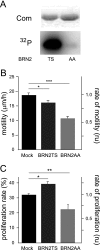
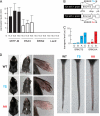

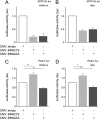
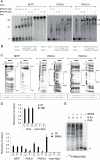
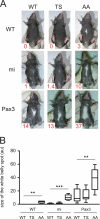
Similar articles
-
Expression of genes for microphthalmia isoforms, Pax3 and MSG1, in human melanomas.Cell Mol Biol (Noisy-le-grand). 1999 Nov;45(7):1075-82. Cell Mol Biol (Noisy-le-grand). 1999. PMID: 10644012
-
A phosphatidylinositol 3-kinase-Pax3 axis regulates Brn-2 expression in melanoma.Mol Cell Biol. 2012 Nov;32(22):4674-83. doi: 10.1128/MCB.01067-12. Epub 2012 Sep 17. Mol Cell Biol. 2012. PMID: 22988297 Free PMC article.
-
A PAX3/BRN2 rheostat controls the dynamics of BRAF mediated MITF regulation in MITFhigh /AXLlow melanoma.Pigment Cell Melanoma Res. 2019 Mar;32(2):280-291. doi: 10.1111/pcmr.12741. Epub 2018 Oct 19. Pigment Cell Melanoma Res. 2019. PMID: 30277012 Free PMC article.
-
Pigmentation PAX-ways: the role of Pax3 in melanogenesis, melanocyte stem cell maintenance, and disease.Pigment Cell Melanoma Res. 2008 Dec;21(6):627-45. doi: 10.1111/j.1755-148X.2008.00514.x. Pigment Cell Melanoma Res. 2008. PMID: 18983540 Free PMC article. Review.
-
The WNT/Beta-catenin pathway in melanoma.Front Biosci. 2006 Jan 1;11:733-42. doi: 10.2741/1831. Front Biosci. 2006. PMID: 16146765 Review.
Cited by
-
Single-nucleus RNA sequencing reveals cell types, genes, and regulatory factors influencing melanogenesis in the breast muscle of Xuefeng black-bone chicken.Poult Sci. 2024 Dec;103(12):104259. doi: 10.1016/j.psj.2024.104259. Epub 2024 Aug 27. Poult Sci. 2024. PMID: 39278114 Free PMC article.
-
Profiling and metaanalysis of epidermal keratinocytes responses to epidermal growth factor.BMC Genomics. 2013 Feb 8;14:85. doi: 10.1186/1471-2164-14-85. BMC Genomics. 2013. PMID: 23391100 Free PMC article.
-
MITF and PAX3 Play Distinct Roles in Melanoma Cell Migration; Outline of a "Genetic Switch" Theory Involving MITF and PAX3 in Proliferative and Invasive Phenotypes of Melanoma.Front Oncol. 2013 Sep 11;3:229. doi: 10.3389/fonc.2013.00229. Front Oncol. 2013. PMID: 24062982 Free PMC article. Review.
-
Octamer-binding transcription factors: genomics and functions.Front Biosci (Landmark Ed). 2013 Jun 1;18(3):1051-71. doi: 10.2741/4162. Front Biosci (Landmark Ed). 2013. PMID: 23747866 Free PMC article. Review.
-
CHARGE syndrome modeling using patient-iPSCs reveals defective migration of neural crest cells harboring CHD7 mutations.Elife. 2017 Nov 28;6:e21114. doi: 10.7554/eLife.21114. Elife. 2017. PMID: 29179815 Free PMC article.
References
-
- Abdel-Malek ZA, et al. 2001. The melanocortin 1 receptor is the principal mediator of the effects of agouti signaling protein on mammalian melanocytes. J. Cell Sci. 114:1019–1024 - PubMed
-
- Andersen B, Rosenfeld MG. 2001. POU domain factors in the neuroendocrine system: lessons from developmental biology provide insights into human disease. Endocr. Rev. 22:2–35 - PubMed
-
- Arozarena I, et al. 2011. Oncogenic BRAF Induces Melanoma Cell Invasion by Downregulating the cGMP-Specific Phosphodiesterase PDE5A. Cancer Cell 19:45–57 - PubMed
Publication types
MeSH terms
Substances
LinkOut - more resources
Full Text Sources
Molecular Biology Databases
